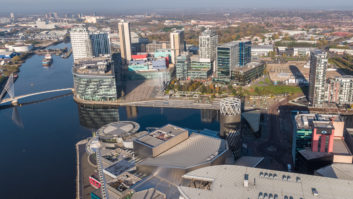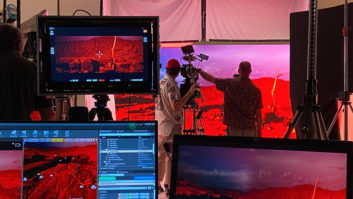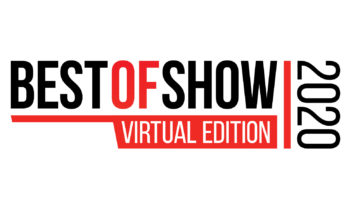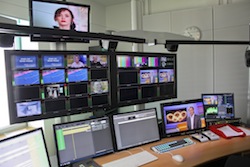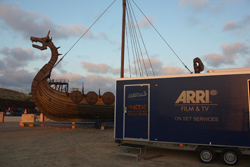
3D Editing Opinion – By Michael Phillips, post solutions manager, Avid Technology.
Stereoscopic editing is an old but revived challenge for filmmakers. Within digital technologies, many of the issues associated with the format in the ‘50s and ‘60s have gone away. For example, elements like film weave on each eye and anaglyph viewings have given way to high resolution and rock-steady images, with higher quality technology that does not affect the colour values of the image.
Avid’s first offering in stereo 3D editing was made available with Media Composer v3.5 software, introduced in March 2009. The release implements a hybrid environment of the existing 2D editing world with 3D viewing. It enables editing to be carried out in 2D within the main editing interface, while the client monitor will play back in stereo 3D when viewed with glasses.
This is essential, as it would be impossible for an editor to sit in front of a system for up to ten hours a day, editing in a 3D format In addition to solving the comfort factor of the editors themselves. It also removes costs. Having to conform left and right eyes for screening adds unnecessary time and expense to the process, when all you really need to do is check a sequence for pace and rhythm. By creating a hybrid workflow for the editor, Media Composer software solves both issues.
The editor’s world
The first version of stereo 3D editing supports what is referred to as an over/under format. This is a single master clip and media file, which encompasses both the left eye view and the right eye view together. As Media Composer software handles metadata better than any other system, tracking left and right eye sources can be done very easily and accurately. Content is handled in separate metadata columns.
For video-based productions, the time code will be the same, but depending on shooting format there may be two tape sources. In file-based workflows, the filenames themselves will be different and can be tracked as such. All of this metadata can be exported as EDLs via Avid EDL Manager and XML via Avid FilmScribe.
For file-based formats, the left and right eye sources can be prepared for editorial using Avid MetaFuze. This free application is available from www.avid.com/metafuze and will take directories of left and right eye files and create over/under files in the Avid DNxHD format. Once the content is in Avid Media Composer software, the editor then chooses which eye they want to be the dominant viewing tool during editing of the 2D view. This is done via the composer’s settings. The choices are:
OFF (over/under)
LEFT (top half only as full 1920 x 1080)
RIGHT (bottom half as full 1920 x 1080)
The next setting affects the full screen playback, which is the signal, carried to the client monitor. This is done via the DVI output of the graphics card. The user can select ‘checkerboard’, which creates the stereo 3D signal used by consumer type monitors and manufactures, such as Mitsubishi and Samsung.
The monitors are rear projection DLP, which use the ‘3D Ready’ tag, as the indication that they support the checkerboard format. Active shutter glasses can then be used with the monitor for stereo 3D viewing. Once the production team is ready to view and edit in 3D, it is a simple process of putting on the glasses and watching the playback in 3D.
The checkerboard setting can be turned off and either a left or right eye view, can be selected to output a full screen 2D version. This setting gives the flexibility to output as needed, for the desired viewing environment and monitoring available.
The 3D offline, online process
In offline, the main job of the editor is to tell a story, so the workflow solutions are the same as conventional 2D storytelling. While in online, 3D specific tools are necessary to correct and sometimes alter the 3D imagery. This process may include colour correction, image sizing, stabilisation and convergence — these can be simple or extensive corrections depending on the subject and complexity of the project.
The editorial team has to take into account the project’s distribution channels and the viewing technology of the consumer. As an example, what works in an IMAX theatre will in most cases have to be altered for television broadcast.
Whether working offline or online, the editing solutions must be transparent to the user to support the relationship between the editor, the script and the story. In the online process, this carries through each part of the finishing steps — from colour correction to effects and compositing, titles and graphics creation. One of the unique challenges posed by finishing in stereo 3D is the addition of ‘real’ creative depth. Now, post teams must carefully consider the placement of titles within 3D space. Titles can be moved in front of or in between the planes of the scene.
Avid is working closely with stereo 3D content creators to enhance the stereo 3D post production process. Additional formats such as interlace and side-by-side were introduced in Media Composer 4.0 (last September) and basic depth grading tools via AVX are currently being investigated. These capabilities allow for even greater control in the storytelling process, resulting in improved efficiencies to ensure the continued success of stereo 3D storytelling.
